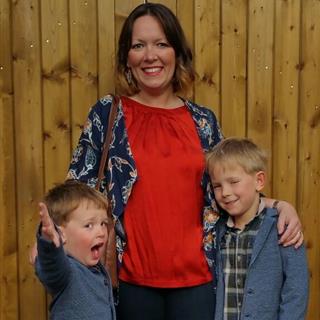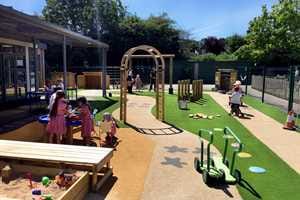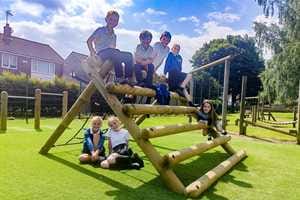
Lesson Ideas and Activities
Tidy Up Time - Fun Ways to Nurture Effective Learners in the Early Years!
Tidy Up Time - Fun Ways to Nurture Effective Learners in the Early Years!
“It’s ‘Tidy Up’ time - time to put your things away!” How do your young learners respond - and how does the anticipation make YOU feel?!
.jpg) Glance around any great Early Years classroom and you will see evidence everywhere (literally everywhere!) that children have been busy having a wonderful time, exploring and discovering new things!
Glance around any great Early Years classroom and you will see evidence everywhere (literally everywhere!) that children have been busy having a wonderful time, exploring and discovering new things!
All those brilliant books, blocks and back-packs, paints, pens and play-train tracks, dough creations, phonics notations, small world any-things and sticky, shiny, every-things!
They all need somewhere to ‘go’, though, at the end of each and every day!
.png)
Clearing up the classroom shouldn’t have to be a rushed, stressful process - at least not most of the time! Some of the most effective Early Years settings consider ‘tidy up time’ as an enriching experience and a valuable part of learning, given everything that happens, everything that children need to be able to do, as part of the process.
Let’s be honest - no Early Years practitioner wants to interrupt children’s imaginative or investigative play by making them constantly tidy up after themselves. Mess is inevitable at this stage of learning! But, it needs to be done at some point if you want to be able to go home at the end of day, knowing that the classroom is ready for whatever tomorrow has in store. With some careful consideration, the daily routine of the classroom clean-up can become a meaningful part of teaching and learning, instilling in children some really important, and useful, concepts and life skills.
And at long last - our new range of accessible, low-level classroom storage furniture is here to enable you and your class to make thoughtful and purposeful tidy-up time a doddle!
You can read more about our exciting new products for the Early Years Furniture range. In the meantime, here are some handy solutions to help you get started making the most of tidy-up time, nurturing effective learners in your Early Years setting….
Clearing up after themselves allows children to develop a good sense of personal responsibility, and having clearly designated storage spaces will help them with this process. They can see that everything in their learning environment has a place where it belongs, and where it can be found when it’s time to play again tomorrow.
.jpg)
Some careful planning as to how their resources are stored will make all the difference, enabling and encouraging EYFS pupils to make independent choices, following through on their own ideas and selecting the resources they want to use, giving them a sense of autonomy. Because the classroom is a shared space, it can be used to give children a sense of community and belonging - somewhere they can take pride in looking after together and recognising as their own.
Consistency is the key - having a familiar routine that happens around the same time and in familiar surroundings is certainly reassuring for children at this young age. It will help children to learn their roles and understand exactly what they need to be doing, when, and why.
As with so many things, it’s all in the details. Tidy up time is not just about them quickly flinging everything into a box - tempting though that may be for some!
We’ve observed some really great, simple techniques happening in EYFS classrooms that help to ensure seamless, efficient and organised tidy up times (there is hope, always hope…!!!)
.jpg)
Clever Storage
Accessible storage, that presents a series of smaller spaces for separating out resources, really helps to make it absolutely clear and easy to see where each resource belongs.
If you have a construction zone, for example, then using a series of smaller containers such as the low-level storage Stack & Sit Stools, with clear-view windows on the sides, avoids children tipping out huge piles of bits and bobs all over the floor.
.jpg)
They can easily see and reach in to choose what they want to play with without the need for spreading everything out everywhere - and it makes things much quicker and easier for them to get going with their creations, then put them away again when they’ve finished.
When it’s time for art, painting, drawing and mark-making - use smaller individual pots or jars to stand pencils, paints, brushes, chalk etc, separately - each one clearly labelled - and display them on low-level shelves that children can reach easily. The key is not to overcrowd them.
Limit the number of these resources that you put out for each session and keep some back as ‘emergency spares’, so there’s less chance of things going a-wander as children are moving around the classroom. Our new Art Easel is brilliant for this as it has built-in shelving for displaying resources for children to use on the spot.
.jpg)
Tip-Out Trays
All the small things - tinkering tools, small world toys, number blocks, counting beads etc - everything for display sits well on a tray! Our Stack & Sit Stools and Benches have removable lids that double-up as excellent tip-out trays for children to set up their chosen resources for play.
The lipped edges prevent everything from rolling out all over the floor, and they even feature designs on the tops to inspire imaginative play. And what’s more - they make it nice and easy for children to carefully tip everything back into the stool when it’s time to tidy up!
Developing Super EYFS Skills!
Tidy up time presents some fantastic opportunities for developing foundation skills across all of the areas of learning. Effective storage spaces can facilitate sorting and classifying activities, with labels, pictures and photographs enabling shape and colour recognition, matching activities, and literacy and numeracy exercises - and things are much more likely to go back in the right place when they’re finished with!
.jpg)
Label the spaces, draw lines on paper or fabric around the bottom of items and cut them out to create templates if it helps - you can stick them onto the shelves to show exactly where you want the resources to go when they’re not in use. Children can match the resources to the template, and you can bring in mathematical vocabulary such as shape names or quantities.
Can you see a photograph of the cutting scissors or a picture of a glue stick? Now you know where to put them back! How many books or blocks, cylinders or cubes belong on this shelf? Can you stack 20 cups together and put them in the cupboard with the red circle on the door? 10 green dinosaurs live here! They’ll be counting objects correctly and exploring concepts such as ‘more’ and ‘less’ as they tidy!
.jpg)
To See or Not to See?
Some resources are much better stored on open shelves rather than in containers - books, wooden blocks, daring dinosaur displays and other such things that can be positioned, stacked or otherwise invitingly presented!
Using a combination of ‘open’ and ‘closed’ storage and shelving for children to access within the classroom is ideal. Being able to tidy some resources away behind cupboard doors helps to keep the space looking less cluttered, and reduces the number of distractions when focused attention is needed during the day, and/or the risk of overwhelming some children with too many resources on view.
.jpg)
Have a think about what you would prefer to keep behind cupboard doors, and use labels to indicate what’s inside for discussion with the children. Using print meaningfully in this way means it’s more likely to be used by the children, and allows you to model early reading strategies, informally, on a regular basis.
Our new Breakout Space classroom furniture is ideal for this, as it offers a combination of open and closed storage and shelving features that can be set up however you choose. You could even designate one cupboard for storing a child-friendly dustpan and brush, a sweeping brush, a feather duster and a few tea towels so they can multi-task with imaginative role play!
Cut the Clutter!
It’s often said that less is more, and to a point, this definitely rings true in the EYFS classroom. Having too many of the same thing - perhaps piles of toy cars, duplicate half-used pots of coloured paint, a few too many sand moulds and overly generous donations of cardboard boxes for crafting - doesn’t always lead to the most effective learning (and will leave you tearing your hair out trying to navigate the space!)
It might sound obvious, but it’s easy to lose track of as the school year goes on. Having fewer resources, just the ones that really matter, stored effectively, will not only save on your budget, but can encourage children to take more care of and pride in them, and will make tidy up time a much more comfortably achievable process.
Tidy to a Tune!
Music and movement make the perfect pair, guaranteed to take the tedious out of tidy up time! It’s good for children to work towards a goal and it’s usually something they really love to do - so pick a cheerful tune to play that gives them the perfect amount of time to tidy up at the end of the day. As soon as they get to know that this music means it’s time to get moving and put away their things, they’ll rise to the challenge and take pleasure in the routine. And that’s a great note on which to end the school day.
.jpg)
.jpg)
.JPG)
.JPG)
.JPG)
.JPG)
.JPG)
.JPG)


